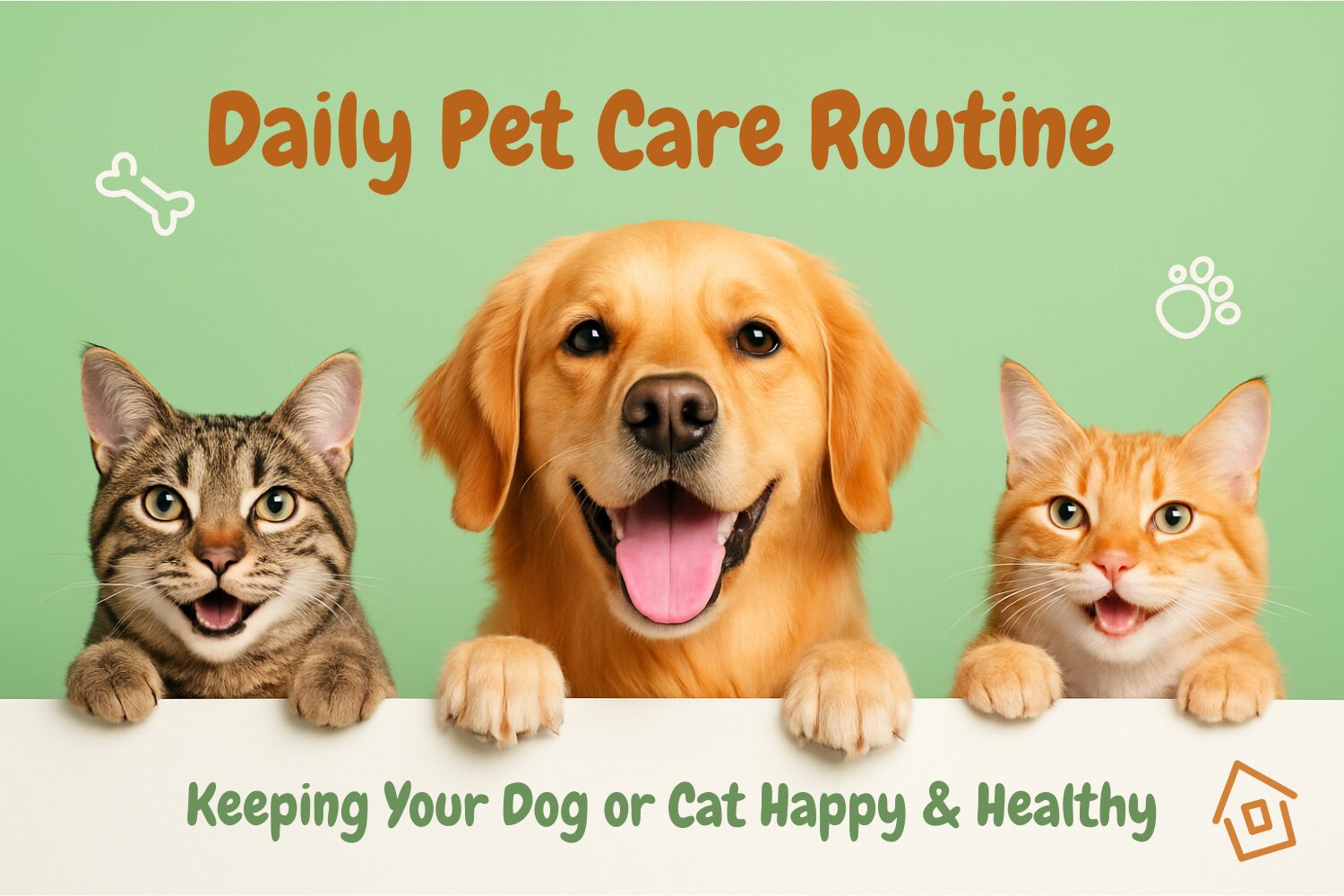Whether you’re a first-time pet parent or a seasoned caregiver, establishing a consistent daily routine is key to your dog or cat’s long-term health and happiness. Like humans, pets thrive on structure, and a few simple daily habits can prevent a host of health and behavior problems down the road.
Let’s break down what an ideal day looks like for your furry friend.
1. Morning Routine: Start the Day Right
Fresh Water & Balanced Feeding
Start by offering fresh water and a portion of high-quality food tailored to your pet’s age and breed. Puppies and kittens often require more frequent meals, while adults usually thrive on two meals a day.
Health & Mood Check
Observe your pet for any signs of discomfort:
- Are they eating normally?
- Is their stool consistent?
- Are they active and alert?
Early signs like lethargy, vomiting, or skipping meals shouldn’t be ignored.
Toilet Time
- Dogs: Take them outside for their morning bathroom break.
- Cats: Scoop out the litter box and observe for any abnormalities in waste.
2. Physical Activity & Play
Physical movement is not optional; it’s essential.
For Dogs:
- Morning walk (15–30 minutes) for fresh air and stimulation
- Allow sniffing — it’s their version of reading the news
- Light play sessions with balls or tug toys
For Cats:
- Encourage jumping, climbing, and chasing with teaser toys
- Offer access to scratching posts or cat trees
- If safe, allow limited supervised outdoor time
Tip: Avoid overexerting senior pets; short, gentle activities are better.
3. Daily Hygiene Essentials
A few minutes of grooming each day helps prevent discomfort and costly vet visits.
- Brushing: Reduces shedding, mats, and hairballs (especially for long-haired pets)
- Eyes & Ears: Gently wipe away any discharge using a damp cloth or vet-approved wipes
- Paws: Check for dirt, debris, or small injuries, especially after walks
- Teeth: Brushing just a few times a week can prevent tartar buildup and bad breath
4. Mental Stimulation & Enrichment
Pets get bored too, and boredom can lead to destructive behaviors.
For Dogs:
- Food puzzles, training cues, scent games
- Rotate toys every few days
- Offer “jobs” for working breeds, like fetching or carrying
For Cats:
- Laser pointers, crinkle tunnels, catnip mice
- Window views with bird feeders outside
- Clicker training or food-hiding games
Even 10–15 minutes of interactive play makes a huge difference.
Also Read: 15 Things Every First-Time Pet Parent Must Know
5. Evening Wind-Down Routine
Pets need winding down, too.
- Final Meal or Treat: Offer a light snack or second meal (if they eat twice a day)
- Bathroom Break: Dogs should be let out one last time before bedtime
- Bonding Time: Cuddle, pet, or brush your pet — this helps reduce anxiety and strengthens trust
- Sleep Space: Clean and cozy bed in a quiet area (dogs) or a favorite perch (cats)
6. Weekly & Monthly Care Tasks
Daily care sets the foundation, but don’t forget the extras:
- Weekly: Nail trims, brushing teeth, deep cleaning food bowls and litter boxes
- Monthly: Flea/tick prevention, weighing your pet, cleaning ears
- As Needed: Vet visits, deworming, updating vaccinations
Keep a checklist to avoid missing any critical health checks.
7. Signs of a Well-Cared-For Pet
Here’s what to look for when your routine is working:
- Healthy appetite and digestion
- Shiny coat and clear eyes
- Energetic but calm demeanor
- Solid sleep routine and minimal behavioral issues
If something feels off, it probably is — trust your instincts and consult a vet.
Also Read: Best Nutrients for Healthy Growth
Daily Pet Care Checklist (Quick Summary)
| Task | Dogs | Cats |
| Feeding | 1–2 times/day (age-dependent) | 2–3 small meals/day |
| Fresh Water | Refilled 2x daily | Refilled 2x daily |
| Bathroom Routine | 2–4 walks/day | Scoop litter box 1–2x/day |
| Physical Activity | 30–60 minutes | 15–30 minutes play |
| Grooming | Brushing + eye/ear check | Brushing + litter cleaning |
| Mental Stimulation | Toys, training, and walks | Toys, climbing, and window time |
| Bonding Time | Cuddle, brush, calm play | Petting, play, brushing |
Final Thoughts
A consistent daily pet care routine helps your dog or cat feel secure, healthy, and loved. It doesn’t require fancy tools or expensive products — just observation, time, and care.
Once your foundation is strong, you can explore specialized wellness additions.
Related blog: How to Boost Your Dog’s Immune System Naturally
FAQ
How many times a day should I feed my dog or cat?
Puppies and kittens may need 3–4 meals. Adults usually do well with 2 meals a day.
Is daily brushing necessary?
Not always, short-haired pets may need brushing only 2–3 times/week, while long-haired breeds may require daily care.
Can I walk my cat like a dog?
Some cats can be leash-trained, but always prioritize indoor safety and gradual acclimation.
What if I miss a walk or grooming session?
One-off misses are fine. The goal is overall consistency; don’t stress over perfection.
How do I mentally stimulate a senior dog or cat?
Use scent games, slow puzzles, or soft toys, and keep the pace gentle but engaging.
How do I know if my pet’s routine is working?
Look for a shiny coat, regular appetite, balanced energy, and a calm demeanor. These are all signs of a happy pet.
About Author
Dr. Kevin Modi
Dr. Kevin Modi is a trusted voice in the Indian pet care space, with years of hands-on experience in pet wellness, gut health, and natural supplements. At GenextPet, he guides product formulation and ensures content accuracy, drawing from real-world insights and the latest research. His goal? To simplify pet health for every dog and cat parent.

